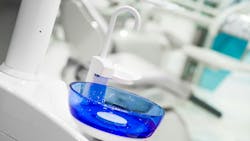The basics of dental unit waterlines: Part 2
What you'll learn in this article:
- How to interpret test results
- What to do if you fail a waterline test
- How to treat dental unit waterlines
- Some common myths about DUWL compliance
Listen to the article on our podcast
Editor's note: This is part two of a two-part series. Read part one.
Dental unit waterlines (DUWLs) continue to be a hot topic in compliance. It’s often met with confusion over how to get the lines to pass. We discussed source water, shocking, and testing in part one of this series on DUWLs. Now, we’ll move into interpreting the test results, what to do if you fail, treating the lines, and some common myths around DUWL compliance.
Interpreting waterline test results
Each test will show results in a different way. Mail-in tests offer a precise CFU count, whereas in-office tests can show growth on a paddle, color change, or a pass-fail line. The results of the test will let you know your next steps. If there are no CFUs or no change in the test, you can continue to the treatment step or shock if it’s part of your maintenance protocol. If there is any growth—even a couple of CFUs or a few dots of growth—definitely shock the lines again. This is what I call “the creep.” It’s a valuable piece of information that a pass-fail test won’t give you. Any growth—even one dot—lets you know the biofilm is proliferating. There is no need to wait until you fail to remediate. It’s like tackling gingivitis and not waiting until it’s full-blown perio or treating an incipient lesion and not waiting until it’s a cavity.
What to do if you fail
If you fail a waterline test, don’t freak out. Congratulations! You are testing, and that’s the first step in making your waterlines safe. And if you fail, know you’re in good company. One-third of all treated lines fail.1
First, check your shock product. Is it one of the stronger ones I mentioned in part one? Consider switching to a stronger product or just a different product in general. Let’s confuse that biofilm! Then, shock three cycles in a row. Depending on the product, that could be three overnights or three 10-minute cycles in a row. This will help to get through all the layers of biofilm that have taken up residence in your DUWLs.
Next, check for dead legs. The line that sits stagnant could be where the biofilm party is happening. Sometimes, the slow-speed handpiece can get water, but since you never use it that way, you forget to check that one. Also, check your source water. What are you filling your bottles with? Is the contamination there? If you are filling from your sink or a distiller, the biofilm could be forming in the aerator on the faucet or the tiny tubing in your distiller.
Speaking of filling your bottle, when was the last time you cleaned it? Many instructions for use (IFUs) recommend cleaning the water bottle on the chair with diluted bleach. And did you know those bottles expire? I thought that was just to sell more bottles, but the plastics can break down, leaving you vulnerable to biofilm growth!
Did you check all your lines to ensure they are drawing from your bottle? Often, rear delivery units pull water straight from city plumbing, not the bottle. If that’s the case, this line isn’t being treated. Consider a filter that connects directly to the untreated line or have your service tech run the line to draw from the bottle. Parkell just released Pure Clarity, an in-line filter that connects directly to a standard lure lock, stopping the biofilm at the filter. It comes with a shock syringe that allows you to shock the rest of the line, keeping the biofilm from getting out of hand.
Lastly, if you are stuck in a fail cycle, don’t fret. I even get failed lines! Biofilm is a beast. Reach out to your treatment product manufacturer, and they might be able to help you isolate the problem.
Treat
While shocking blasts out the biofilm—much like what we do during a periodontal maintenance visit—using a treatment product is like home care, keeping the biofilm at bay until the next visit/shock.
There are lots of great treatment products on the market. There are tablets you put into the water bottles daily, treatment straws that attach to the uptake tube in the bottle, and liquids that can act as a shock or treatment. And not to sound like a broken record, but you must follow the IFUs for your chosen product. No matter what product you use, you must continue to test. All products work, and all products fail. Biofilm is tricky that way.
If using a tablet, pay attention to the dilution instructions. In my office, we discovered that our unit water bottles were all different sizes. So, simply dropping in a tablet and filling up the bottle wasn’t working, because some bottles were getting overdiluted. We ended up putting lines on our bottles with a permanent marker, so we knew where to fill them to. We also could have mixed the tablet water in a gallon jug and filled the bottles from there. Depending on the tablet, the active ingredient is good for 14-28 days.
When treatment straws came on the market, many well-meaning salespeople told offices all they had to do was attach the straw, and then their lines were good for a year. But this treatment is not a “get out of jail free card.” Many of the straws on the market are good for one year or 240 liters. I don’t know about you, but I don’t count how many times I fill the bottle—and that’s with good quality water on clean lines. What if your lines already have some biofilm in them or if your sink aerator is a little dirty? Then, the straw has to work that much harder, and it might run out of active ingredients before the year is up. There are now six-month straws on the market as well as one-year, but no matter what, you must keep testing to know they are still up to the task.
Flush versus purge
I’m often asked about emptying bottles at night or purging the lines at the end of the day. Once again, the answer goes back to the IFUs for the treatment product you’re using. Some products recommend leaving the treated water in the lines overnight and on weekends. Then, it can fight biofilm growth while you’re at home. Purging is often recommended only if the lines sit stagnant for two weeks or more. Then, it’s recommended to shock before reopening the operatory.
No matter what product you use, you should flush the lines for 20-30 seconds at the beginning and end of the day and between patients to physically flush out patient material that might have entered the dental water system during treatment.2
Maintain and document
Establish your office standard operating procedure (SOP) in writing so everyone knows what to do. When I lecture to dentists and hygienists, they often assume their assistant is on top of this. But what if they aren’t? That can affect both your patients’ health and yours!
Be sure to document your results. Like anything in dentistry, if you don’t write it down, it didn’t happen. Take a picture of your chairside test with the date and lines or operatory tested. With mail-in tests, be sure to save the report from the lab. Many companies offer free online dashboards to store this information. Check with your testing company to see if this is an option. States vary on how long this information is stored. Keep your data for five years if you can’t find your state requirement.
Surgical procedures
All this water talk has been focused only on nonsurgical dental procedures. Any surgical procedures require sterile water through a sterile delivery device. You cannot simply pour sterile water into your dental water bottle and expect it to come out sterile. The CDC defines surgical procedures as “the incision, excision, or reflection of tissue that exposes the normally sterile areas of the oral cavity.” Examples can include biopsy, periodontal surgery, implant surgery, endo, and pulpotomies.3
Myths
One common misconception I hear is, “We use distilled water, so we don’t have to do any of this.” However, many chair manufacturers no longer recommend distilled water due to its corrosive tendencies. And biofilm can (and does) grow in the lines with distilled water.
Another confusion occurs when the water comes straight in from the city without a way to shock and treat it. Your office has some decisions to make. Install a centralized system or retrofit the chairs with bottles to ensure the water going into your patients’ mouths and the aerosols you breathe daily meet the EPA standard for safe drinking water.
Waterline warrior
While DUWL safety might seem like a lot, the great thing about compliance is that you can test to see if what you are doing is working or if it’s time to troubleshoot. Thankfully, there are many experts out there to help you pass the test! You are well on your way to becoming a waterline warrior!
Editor's note: This article appeared in the June 2025 print edition of RDH magazine. Dental hygienists in North America are eligible for a complimentary print subscription. Sign up here.
References
- Molinari JA, Dewhirst N. Treating and monitoring dental water. Compend Contin Educ Dent. 2018:11-21.
- Mills S, Porteous N, Zawada J. Dental unit water quality: Organization for Safety, Asepsis and Prevention white paper and recommendations. J Dent Infect Control Safety. 2018;1(1):12-12.
- Best practices for oral surgical procedures. Centers for Disease Control and Prevention. Accessed March 17, 2025. https://www.cdc.gov/dental-infection-control/hcp/dental-ipc-faqs/oral-surgical-procedures.html
About the Author

Amanda Hill, BSDH, RDH, CDIPC
Amanda Hill, BSDH, RDH, CDIPC, is an enthusiastic speaker, innovative consultant, and award-winning author who brings more than 25 years of clinical dental hygiene and education to dentistry. Recipient of ADS’s Emerging Infection Control Leader award and an active participant with the advisory board for RDH magazine, DentistryIQ, and ADS’s Infection Control in Practice Editorial Review Board and membership committee, Amanda (also known as the Waterline Warrior) strives to make topics in dentistry accurate, accessible, and fun. She can be reached at [email protected].

